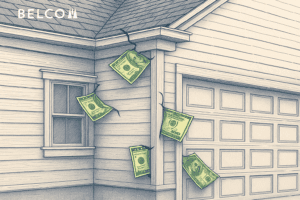Where To Use Belly Band Trim
Believe it or not, belly band trims can make or break the appearance of a home. You don’t want to overdo it though, or it can cheapen the look.
However, too few belly band trims can leave a house looking blah.
Belly bands are often be found in gables, separating standard lap or panel siding from shake. They are also used on larger homes or apartments to serve as a material break between floors.
This trim is often used as a visual separation between two surface materials. You can learn morea about trim from our article Selecting the Best Insect and Rot-Resistant Wood Trim.
Belly band trims really shine when two different materials of different thicknesses are placed next to each other. The band is thicker than the siding they are attached to and unifies the disparity of the two boards.
Belly Band Trim Materials
Exterior trim is commonly made from all wood components or man-made manufactured products. There are compelling reasons to use each one. First I’ll take a look at the real wood options.
Real Wood
There are two options for real wood trim for belly boards: cedar and primed white wood. Let’s take a look at each option.
Primed White Wood
Primed white wood has in the past gotten bad marks for being too easily prone to rot and decay. This is actually true. However, today with Belco XT® Trim, those concerns are non-existent.
PWW is lightweight, easy to install, doesn’t require special tools to use and it is available up to 20′ in length. In addition, it won’t swell up when wet.
Other brands of PWW have lower resistance to rot and decay. Belco XT® Trim is the best of all worlds.
Belco XT® Trim is kiln-dried to an ideal moisture content. Then an excellent wood preservative is applied to the raw wood surface. This ensures that the preservative sinks into the wood fibers well. Competitor’s products have a preservative that is merely mixed into the paint.
After further drying, it is then painted with a quality white primer and travels through our drying ovens.
The results are a PWW Belco XT Trim that is backed with a 20-years warranty against rot, mold, and mildew. Even cedar can’t make that claim.
Belco XT® Trim is the easiest installed, most worry-free belly band trim on the market today.
Cedar
Cedar is an excellent choice for belly band trims. It is naturally decay resistant, easy to cut and installs without any special tools. It is much more lightweight than OSB or fiber cement. Cedar is relatively strong and beautiful.
It has a few downsides, though. The primary one being cost. Cedar is very expensive. It is out of most people’s budget.
It is also becoming increasingly hard to find.
Cedar does not come with a warranty for the consumer.
Non-Wood and OSB Trim
Man-made materials incorporate additions of resins mixed with wood chips (OSB) of cement mixtures formed into trim. In certain applications, they are very popular. First I’ll introduce fiber cement.
Fiber Cement
Fiber cement is a common trim material used today. The same material is used for all the trim on a home. This creates unity of design and makes it easier to follow up with any warranty issues.
Fiber cement may work well in some trim applications, but with belly band specifically, it is not a very good fit.
For starters, fiber cement belly band trim does not come in larger nominal sizes. The thickest option available is 1 inch. One of the main purposes of belly band is to connect two different siding board thicknesses. For it to work best, the belly band needs to be thicker than the largest board.
Another thing to consider is the weight. Fiber cement is really heavy. It averages 60% heavier than real wood. Installers slow down with heavy material. As a result, fiber cement can increase the cost of installation.
Due to its weight, fiber cement is only offered in 12′ lengths. However, most areas that use belly bands are well over 12′ long. Therefore, jointing is necessary, which means more potential areas for caulk to fail, and a greater potential for water intrusion.
It is common for belly bands to be installed in high places. When repairs are needed, it requires climbing a ladder to reach the damaged area. For safety, it is best to use a long-lasting belly band.
Why take chances on chipping and cracking? XT Trim by Belco is a better choice for belly bands.
Engineered Wood/OSB
Engineered wood trims are another common material for belly bands. They are much lighter weight than fiber cement, which saves wear and tear on the installer and speeds installation times.
OSB has an advantage because it is offered in 16′ lengths. This limits butt joints that will need caulking.
Sounds like a perfect fit, right? Well, not so much. OSB boards are truly strong due to the high resin content binder. But, the ends of each board are vulnerable to water, causing swelling that does not revert to the original shape once dry.
Because belly bands are the thickest horizontal siding component on a wall. Therefore they naturally provide a flat surface for water to collect on.
In theory, flashing should protect the band from any puddling water. In reality though, as the house settles and weather does its damage, the flashing moves enough that water all too often finds a way in.
Once the OSB band swells, it can hold the flashing out further, allowing easier access for more water and a vicious cycle continues.












